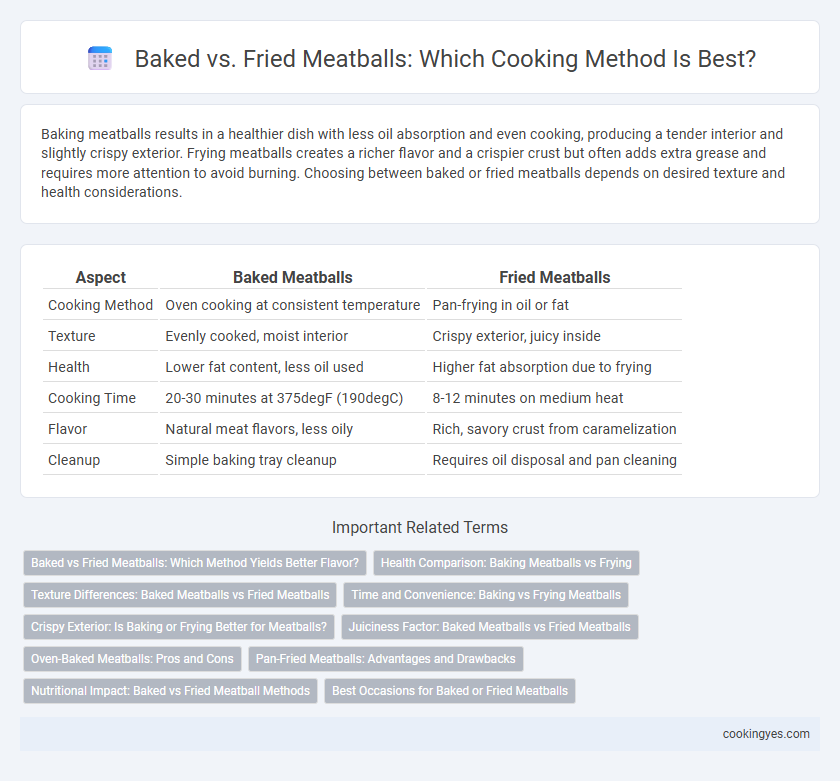Baking meatballs results in a healthier dish with less oil absorption and even cooking, producing a tender interior and slightly crispy exterior. Frying meatballs creates a richer flavor and a crispier crust but often adds extra grease and requires more attention to avoid burning. Choosing between baked or fried meatballs depends on desired texture and health considerations.
Table of Comparison
| Aspect | Baked Meatballs | Fried Meatballs |
|---|---|---|
| Cooking Method | Oven cooking at consistent temperature | Pan-frying in oil or fat |
| Texture | Evenly cooked, moist interior | Crispy exterior, juicy inside |
| Health | Lower fat content, less oil used | Higher fat absorption due to frying |
| Cooking Time | 20-30 minutes at 375degF (190degC) | 8-12 minutes on medium heat |
| Flavor | Natural meat flavors, less oily | Rich, savory crust from caramelization |
| Cleanup | Simple baking tray cleanup | Requires oil disposal and pan cleaning |
Baked vs Fried Meatballs: Which Method Yields Better Flavor?
Baked meatballs offer a juicier interior and a more evenly cooked texture, preserving natural flavors without excess oil absorption. Fried meatballs develop a crispy, caramelized crust that enhances the savory profile through Maillard reaction, providing a richer, deeper taste. The choice between baked and fried depends on desired texture and flavor intensity, with frying yielding a more intense, crispy exterior and baking promoting tenderness and moisture retention.
Health Comparison: Baking Meatballs vs Frying
Baking meatballs significantly reduces fat content compared to frying, as excess grease drains away rather than being absorbed during cooking. This method retains more nutrients while lowering calorie intake, making baked meatballs a healthier option. In contrast, frying increases fat and calorie content due to oil absorption and can introduce unhealthy trans fats if cooked at high temperatures.
Texture Differences: Baked Meatballs vs Fried Meatballs
Baked meatballs tend to have a firmer and more even texture due to the consistent heat distribution in the oven, which allows them to cook thoroughly without excess oil absorption. Fried meatballs develop a crispy, golden-brown exterior from direct contact with hot oil, creating a contrast between the crunchy outside and moist interior. Texture preferences vary, with baked meatballs offering a denser bite and fried meatballs providing a crispier, more indulgent mouthfeel.
Time and Convenience: Baking vs Frying Meatballs
Baking meatballs typically takes 20-25 minutes at 400degF, offering a hands-off, convenient cooking method with even heat distribution and less cleanup. Frying meatballs usually requires 8-10 minutes on medium heat, providing quicker results but demands constant attention and can result in greasy residue. For time efficiency and low-maintenance preparation, baking is ideal, while frying suits those seeking faster, crispier texture with more active cooking.
Crispy Exterior: Is Baking or Frying Better for Meatballs?
Frying meatballs creates a superior crispy exterior due to direct contact with hot oil, which quickly seals the surface and enhances browning through the Maillard reaction. Baking can produce a slightly crispy outer layer but typically results in a softer texture as heat is distributed more evenly and lacks constant oil immersion. For optimal crunchiness, frying is the preferred cooking method to achieve a golden, crisp crust on meatballs.
Juiciness Factor: Baked Meatballs vs Fried Meatballs
Baked meatballs retain juiciness by cooking evenly at a consistent temperature, allowing internal moisture to stay sealed without excessive oil absorption. Fried meatballs develop a crispy exterior from high heat immersion, but the intense direct heat can cause quicker moisture loss, leading to a drier interior. Choosing baking enhances moisture retention for tender, juicy meatballs, while frying prioritizes texture over juiciness.
Oven-Baked Meatballs: Pros and Cons
Oven-baked meatballs retain juiciness without excess oil, making them a healthier option with even cooking. The baking process enhances flavor through caramelization while reducing mess compared to frying. However, oven-baked meatballs may lack the crispy exterior texture that frying provides, and require longer cooking time.
Pan-Fried Meatballs: Advantages and Drawbacks
Pan-fried meatballs offer a crispy exterior and rich flavor due to direct contact with hot oil, enhancing texture and taste. This method allows for quick cooking and better control over browning, but it may result in uneven cooking if not carefully managed, and requires more oil, increasing fat content. Pan-frying also demands active attention to prevent burning and ensures the internal temperature reaches safe levels to avoid undercooked centers.
Nutritional Impact: Baked vs Fried Meatball Methods
Baked meatballs retain more moisture and have lower fat content compared to fried meatballs, making them a healthier cooking method. Frying meatballs increases their calorie count and saturated fat levels due to the absorption of oil during cooking. Choosing baked meatballs supports reduced fat intake and better heart health while maintaining protein quality.
Best Occasions for Baked or Fried Meatballs
Baked meatballs are ideal for large gatherings or meal prepping due to their even cooking and ease of preparation in bulk. Fried meatballs offer a crispy exterior suitable for appetizer platters, party snacks, or occasions where texture and quick cooking are essential. Choosing between baked or fried methods depends on the desired texture and event setting, with baked favoring convenience and fried enhancing flavor through browning.
Baked vs Fried for Meatball Cooking Method Infographic

 cookingyes.com
cookingyes.com